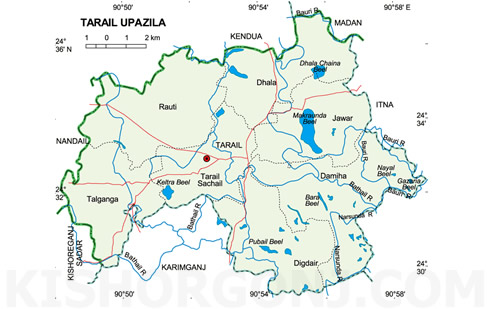
Tarail Upazila (kishoreganj district) with an area of 141.46 sq km, is bounded by kendua and madan upazilas on the north, karimganj upazila on the south, itna upazila on the east, nandail and kishoreganj sadar upazilas on the west. Main rivers are Narsunda, Bauri and Bathail.
Tarail (Town) consists of one mouza. The area of the town is 2.70 sq km. It has a population of 7487; male 52.32%, female 47.68%; population density per sq km 2773. Literacy rate among the town people is 35.5%. The town has one dakbungalow.
Administration Tarail thana, now an upazila was established in 1918. The upazila consists of 7 union parishads, 75 mouzas and 104 villages.
Archaeological heritage and relics Jowarr Saheb Bari Mosque (941 AH), Mosque at Village Parura (Mughal period).
Population 138488; male 51.60%, female 48.40%; Muslim 93.52%, Hindu 5.71%, Christian 0.32%, Buddhist 0.31% and others 0.14%.
Religious institutions Mosque 167, temple 7, tomb 2, most noted of which are Sekander Nagar Mosque, Tarail Bazar Bara Mosque.
Literacy and educational institutions Average literacy 12.6%; male 20.2% and female 3.7%. Educational institutions: college 1, high school 8, junior high school 1, madrasa 6, government primary school 46, community school 20. Noted old institution: Tarail Pilot High School (1945).
Cultural organisations Club 2, voluntary organisation 20, cinema hall 2, circus party 1, literary society 1, playground 21.
Main occupations Agriculture 42.69%, fishing 2.51%, agricultural labourer 28.49%, wage labourer 3.88%, commerce 9.23%, service 2.46%, others 10.74%.
Land use Total cultivable land 11740.19 hectares, fallow land 1623.72 hectares; single crop 44%, double crop 43% and treble crop land 13%. Cultivable land under irrigation 75%.
Land control Among the peasants, 42.10% are landless, 41.68% small, 14.73% intermediate and 1.49% rich.
Value of land The market value of land of the first grade is Tk 4000 per 0.01 hectare.
Main crops Paddy, wheat, jute, mustard seed.
Extinct or nearly extinct crops Linseed, sesame, aman paddy (Baua) and varieties of pulse.
Main fruits Mango, litchi, kul.
Fisheries, dairies, poultries Poultry 33, fishery 21, hatchery 1.
Communication facilities Roads: pucca 35 km, semi pucca 12 km and mud road 209 km; waterways 11 nautical mile.
Traditional transport Palanquin, horse carriage and bullock cart. These means of transport are either extinct or nearly extinct.
Manufactories Ice factory 5, saw mill 3, rice mill 15, welding 7, soap factory 1, bakery 3.
Cottage industries Bamboo work 255, goldsmith 28, blacksmith 55, potteries 72, wood work 50, tailoring 150.
Hats, bazars and fairs Hats and bazars are 7, most noted of which are Tarail, Jowar, Parura, Taljanga, Bauti, Banail; fairs 3 (Austomi Mela, Baruni Mela and Rathyatra Mela).
Main exports Paddy, jute and mustard seed.
NGO activities Operationally important NGOs are brac, asa, Swanirvar and Prokash.
Health centres Upazila health complex 1, family planning centre 4, rural health centre 2. [Muhammad Tofazzel Hussain Khan]